The concept of five-star elegance and luxury is not the same all over the world. In a city like London, for example, it can happen that inside an early nineteenth-century hotel, in the spaces of a three-Michelin-starred restaurant, the working and operational areas of the staff are conceived on a par with - if not more than - those reserved for the public. It can happen that at the table one dines without a tablecloth, with rhythmic jazz in the background and a very dynamic, informal yet distinguished service. Some call it professional but friendly, and I would say that it represents a perfect synthesis of an approach capable of making every type of customer feel at ease, whatever the occasion.
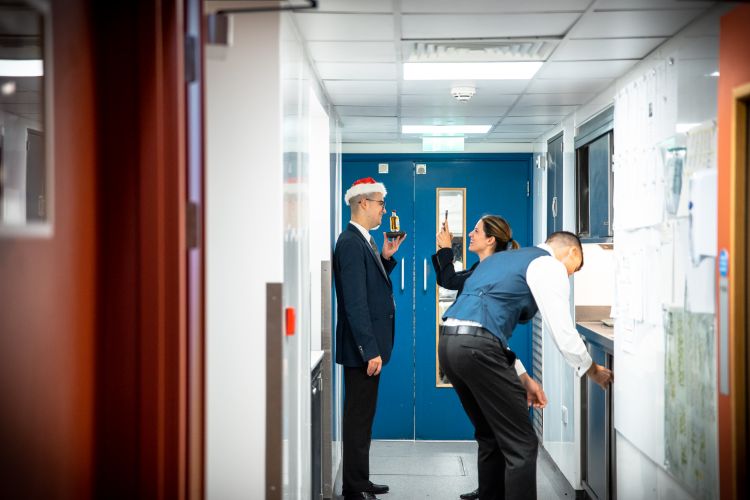
If this skill is so widespread among the many Italians who have moved abroad and are now working in the hospitality and food and beverage industry, this same attitude, alas, is not shared by Italians at home, who tend to be overly formal and take themselves too seriously. Hélène Darroze at The Connaught is the perfect example of what could be described as a new model of savoir faire and hospitality with an international flavour and a clear Italian-European matrix. A good part of the dining room staff, starting with Maître Mirko Benzo, has Italian origins and significant previous experience while, in the kitchen, the position of Executive Chef has been in the hands of Marco Zampese for eight years. Only thirty-four years old and with two feet firmly planted in his kitchen, Marco is one of those compatriots to be proud of for his ability to represent the best of our country. A solid man, a conscientious professional with the attitude of someone who never feels satisfied and accepts to constantly put himself on the line. The right arm of Hélène Darroze, the leader of his kitchen, the mastermind behind many of the recipes now on the menu, Zampese can count on a close-knit and efficient team. There are young people from all over the world; the preparations are many and laborious; there are two services every day, at lunch and dinner, not counting the chef's table that overlooks the kitchen.
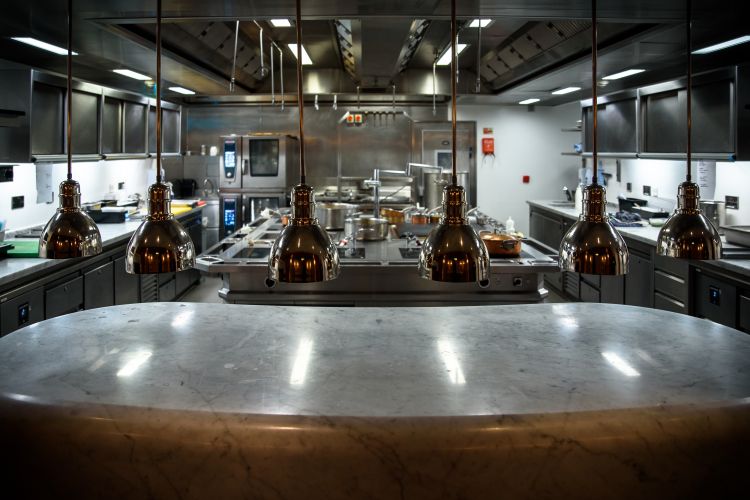
The chef's table can accommodate up to 10 guests
‘There is no weekend or empty day: we are fully booked every day we are open, seating a total of almost fifty people, without double shifts of course. The table in the kitchen can seat up to ten people and is very often reserved for special occasions, anniversaries, birthdays, important corporate events,' maître Benzo tells us. About half an hour before the arrival of the guests, all the floor staff, including the sommelier, get together for a short briefing.
Every day guests, journalists, VIPs, internationally renowned chefs, the occasional film star, come and go: it's good to be prepared to recognise them, to be aware of any allergies or intolerances and to have a few conversation topics ready to keep as a trump card. The dining room at Hélène Darroze at The Connaught has large windows overlooking onto the Carlos Place esplanade, accommodating guests in antique pink and cerulean velvet sofas, seated at light wood tables.
For those who prefer more privacy, there is a small room where it is possible to have lunch as a couple, surrounded by the family's vintage Armagnac collections from the 1960s to the present day. Because of the very central location, many guests do not stay at the hotel, but dine here on business or leisure: 20% at least are Americans, many Asians who are crazy for selfies and photographs for social media, and the remainder are Europeans and French.
‘The transition from the second to the third star in 2021 is most noticeable in the clientele: absolutely happier, predisposed and genuinely excited about coming to see us. At first I was a little worried about the pressure we might have received, a slight performance anxiety, also because we have enlarged the team, having a higher and more constant occupation of the restaurant. A transition that did not go unnoticed, we can say. This, however, has meant that we have focused even more on our work, maintaining Hélène's philosophy where service, cooking, and timing are always a priority,' Zampese tells us. Again, hearing the chef speak, one felt - and continues to feel - a change in mentality post Covid and - now - post Brexit.
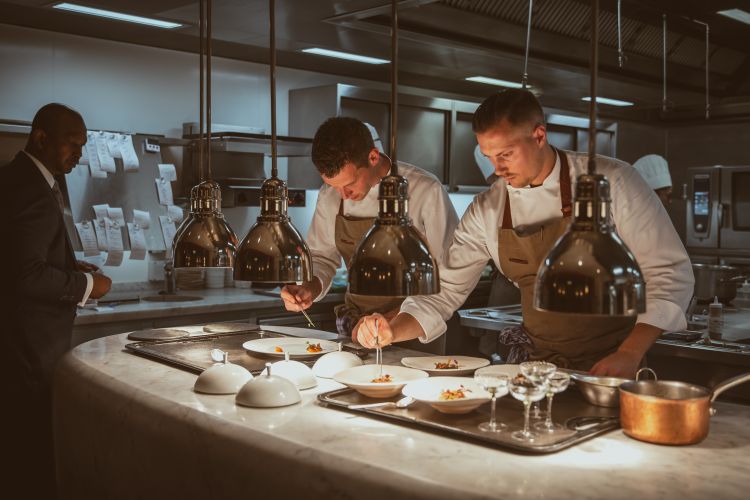
‘Whereas we used to get fifty CVs per month, today we get ten and the first question from each candidate is always about working hours. Before, in fine dining, it was inconceivable to work 17-18 hours a day. Now clearly we have had to downsize and adapt. This is also why we’re only open five days a week - only in December it will be six - and the staff is always rotating.
On average, staff members stay here one or two years, enough to learn the mechanisms of such structured realities, build up a wealth of experience and then apply elsewhere'. In the last year, the staff has been renewed by about 40%, leaving out key figures such as the executive or the sous chef, who have a career history and affection with Hélène Darroze lasting over the years. The team at the three-starred London restaurant now has a total of twenty-seven people in the kitchen alone, fifteen of whom are permanent staff and four in the patisserie.
The gastronomic experience partly recounts the rich and valuable French tradition of a female chef with character such as Hélène Darroze, while leaving room for Marco Zampese, who over the years has managed to carve out his own space and identity within the menu.
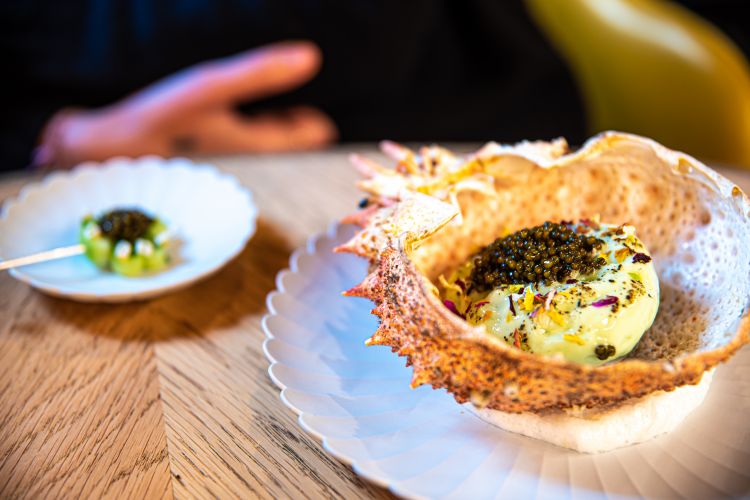
Breton smoked eel, daikon, timut pepper clam consommé and Basque txangurro with crab meat, Chinese caviar from the Amu River and cucumber mousse
Our lunch starts with an unexpected combination: Breton smoked eel, daikon, timut pepper clam consommé. Alongside, a rather intense Basque counterbalance: a reinterpretation of the traditional Basque txangurro made with crab meat is presented in a crab shell, with Chinese caviar from the Amu river and a soft cucumber mousse. A journey that starts in France with a firm hand, preparing the mouth to fly over intense flavours, but mitigated by the freshness of roots and vegetables. To experiment and break the usual dictates, we turned to Lucas Reynaud-Paligot for a pairing that ranged from alcohol free drinks, wine, extracts to traditional mixing.
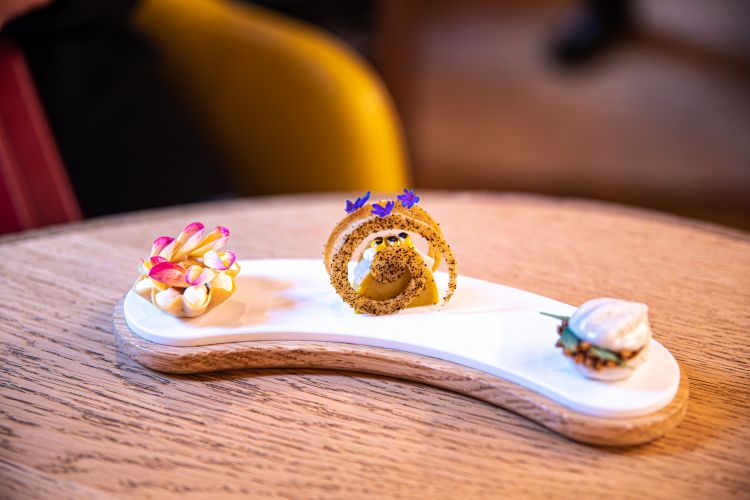
The entrées during a wonderful lunch at the Hélène Darroze at the Connaught
Opening the dances along with the first entrées was an off-list Negroni, in its more traditional version and in the one made with Armagnac - a tribute to the chef – a trio of bitters, red vermouth and a vapour of woody, citrus essence. The match with cucumber is particularly successful.
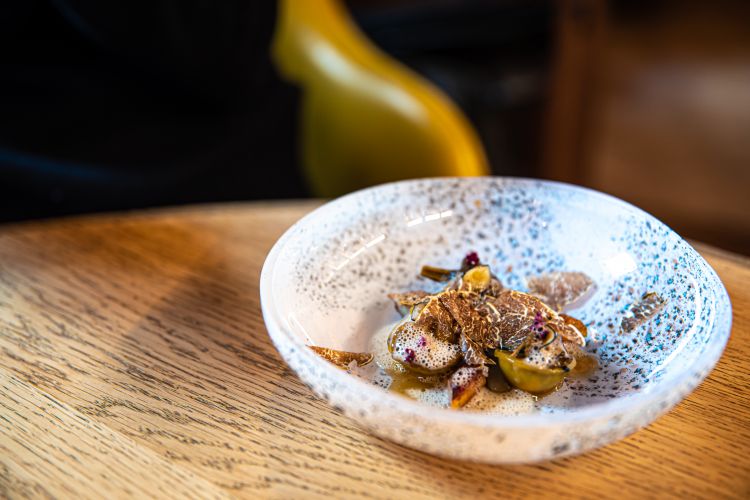
Ravioli stuffed with guinea fowl ragout, mushroom mousse, hazelnuts and white Alba truffle
Next, Ravioli stuffed with guinea fowl ragout, served with a light mousse of mushrooms, hazelnuts and white Alba truffle. The guinea fowl is beautifully cooked, without getting lost in the ravioli – it has just the right texture and thickness - and the intensity of the meat is underlined by the earthiness of the mushroom and accentuated by the white truffle. For the non-alcoholic side, a drink made with a homemade pine and green apple syrup, finished with a light soda top. On the wine side, we enjoy a 2018Calinfornian Chardonnay Shafer, fresh and mineral. At this point the chef treats us to a small interval between courses, which could actually be a dish in its own right given its prestige: fried foie gras, light buckwheat breadcrumbs and white melon.
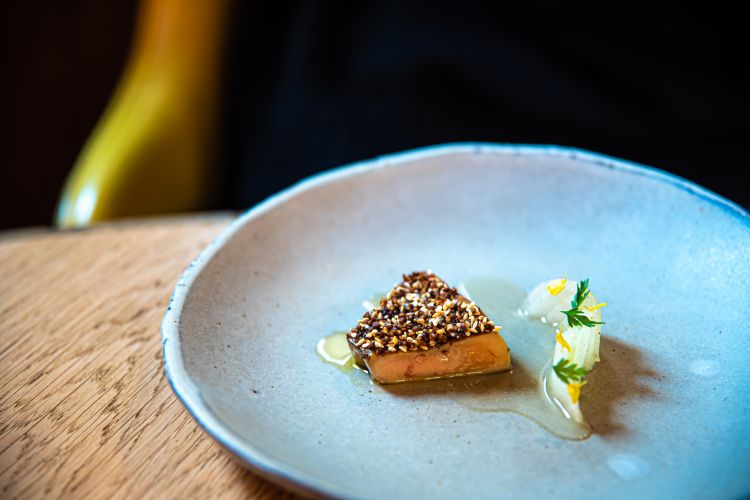
Fried foie gras, light buckwheat breadcrumbs and white melon
Here Lucas pulls off a masterstroke: apple cider, Cidre du Saint Bernard Maley, and white Sauvignon grape jus produced by Alain Millat. A seemingly daring journey, but one that actually amazed us with its perfect response to the fattiness of the dish. The cider with its light carbonation and minimal acidity offers an excellent contrast to accompany the foie gras and cleanse the mouth. At the same time, for those who like softness, comes the totally non-alcoholic grape/wine juice which with its sweetness leaves a sugary note that envelops everything. There are two main courses: a seafood and a land dish in an ascending climax (and how could it be otherwise!).
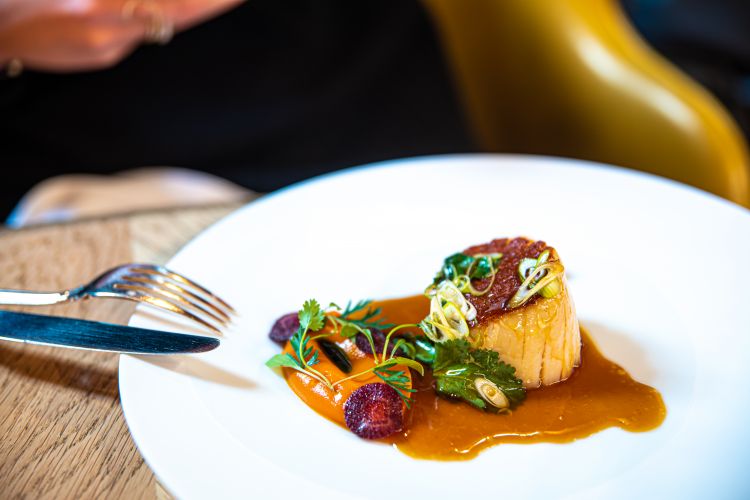
XXL scallop, lemongrass, coriander, carrot, tandoori, spring onion
It starts with an XXL scallop, with a hint of oriental flavours of lemongrass, coriander, carrot, tandoori, spring onion, and ends with a Cornish sea bass treated exactly like a cut of meat. The fish fillet is served with chopped chestnuts - reminiscent of white meat banquet stuffing - endive, salsify root and red wine Matelote sauce. The wines in this case are a 2019 Casa Marchionni Trebbiano and a 2020 Garnacha from Castilla region, from Gomez Landi.
If at this point the meal usually draws to a close, here we are at the climax of the performance, when the highlights make their entrance. The baton passes to the meat with a French guinea fowl raised by Arnaud Tauzin, stuffed under the skin with foie gras, herbs, pan brioche and served with beer-braised shallots and capers.
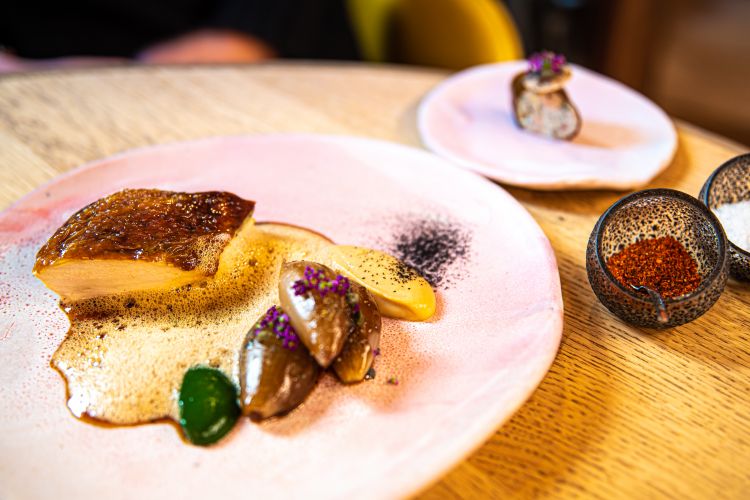
Guinea fowl stuffed with foie gras, herbs, pan brioche and beer-braised shallots and capers
The beer used here is Ola Dubh, Scottish and matured in whisky barrels. The second meat dish is barbequed Wagyu beef fillet from the Gunma prefecture, served with a mix and match of potatoes in different cookings, shapes and textures and accompanied by an Amalfi lemon sauce. The flair of a young sommelier finds here its maximum impetus with 2015 Rosso di Montalcino - pure Sangiovese - from Poggio di Sotto and an extract of beetroot, tomato, Tasmanian pepper, Worcestershire sauce and cloves as a non-alcoholic pairing (risky, but welcome).
Dulcis in fundo: Hélène Darroze's indispensable baba, bathed in the customer's choice of Armagnac from 1995 to 2005 and filled with raspberries.
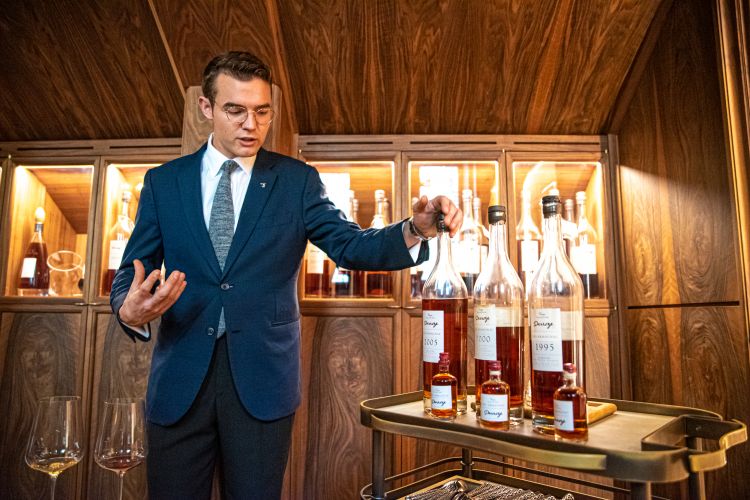
A selection of Armagnac to wet the iconic baba
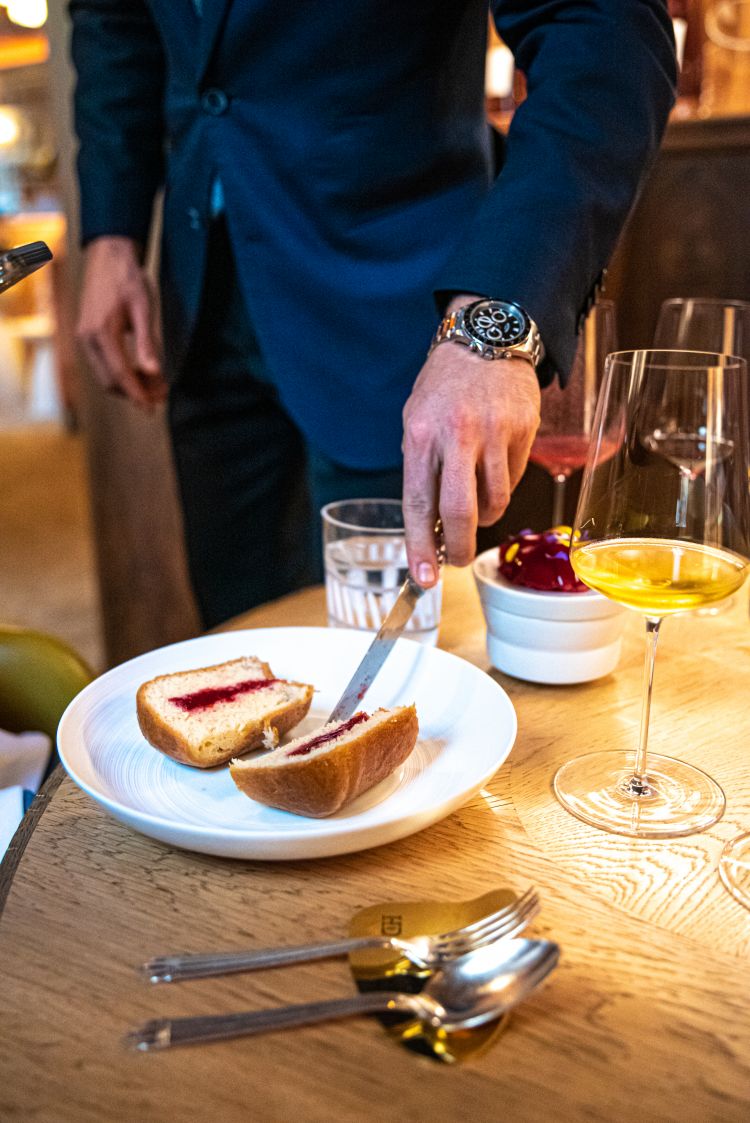
A must-have at Hélène Darroze at the Connaught: the baba soaked with the customer's choice of Armagnac 1995 to 2005, filled with raspberries
Regardless of your relationship with this iconic Italian traditional dessert, this dish cannot be missed to complete such a significant journey in the cuisine of a multi-starred chef. Both in terms of service and clearly in terms of quality of workmanship. If you are less fond of the alcoholic notes, a mousse of Vietnamese chocolate, buckwheat and fermented black garlic will give you pure emotions. A dessert in constant evolution of flavours and textures and with that slight aftertaste from fermentation that gives it both aroma and acidity.
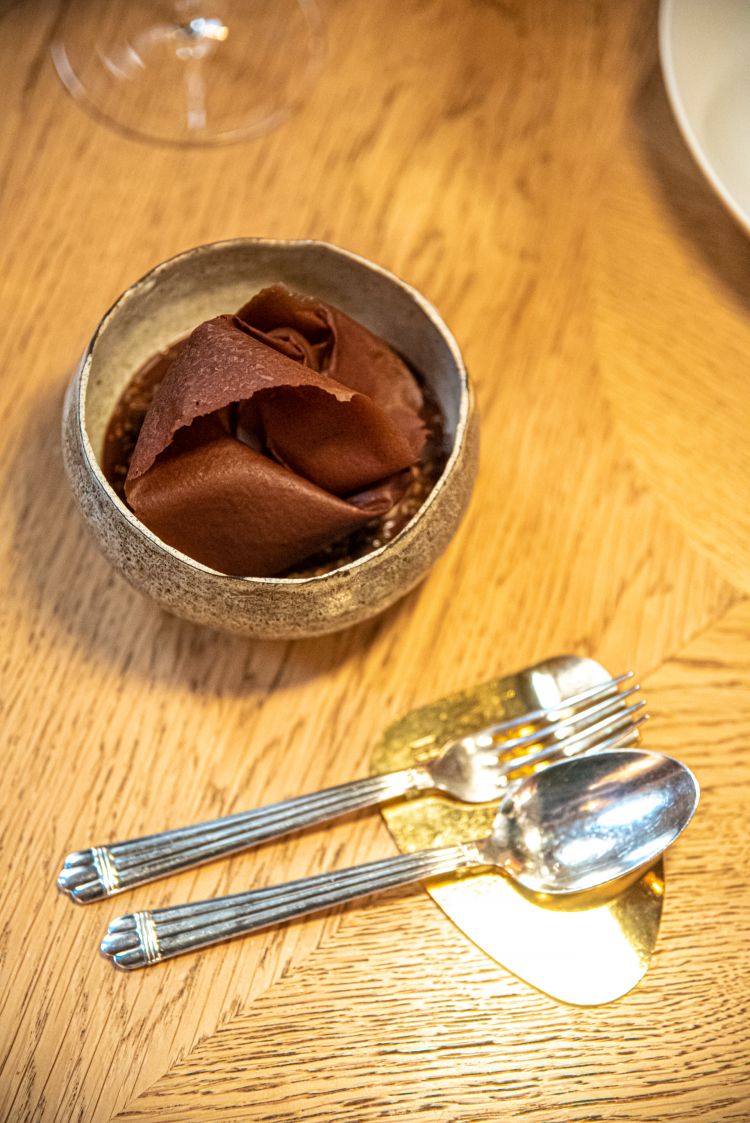
Vietnamese chocolate mousse, buckwheat and fermented black garlic
A lunch, a dinner where every dish is perfectly understandable to the customer, where the combination of a important made-in-UK raw materials and equally finely selected French raw materials meet in respect of the tradition of these two neighbouring Atlantic regions.
Perhaps one of the great virtues of almost-timeless restaurants, enduring over the years because of the all-round quality of their service, is precisely this: offering damn good, masterfully executed dishes.
Translated into English by Slawka G. Scarso